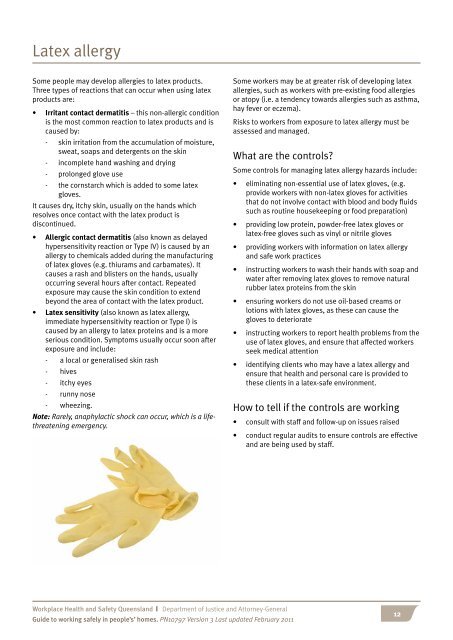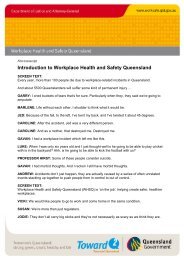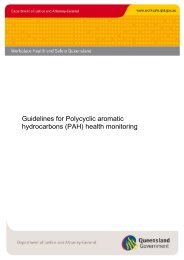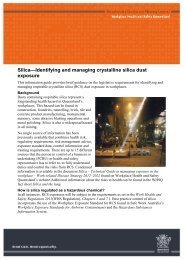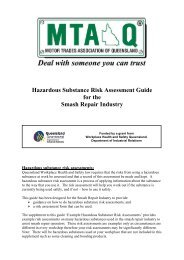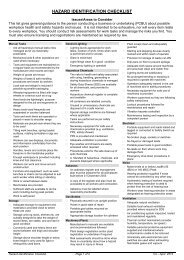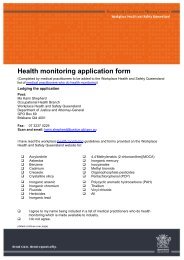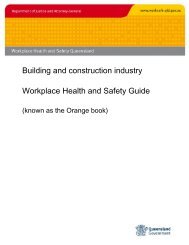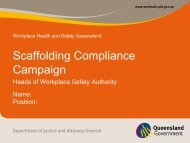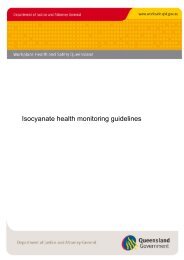Guide to working safely in people's homes - Queensland Government
Guide to working safely in people's homes - Queensland Government
Guide to working safely in people's homes - Queensland Government
Create successful ePaper yourself
Turn your PDF publications into a flip-book with our unique Google optimized e-Paper software.
Latex allergy<br />
Some people may develop allergies <strong>to</strong> latex products.<br />
Three types of reactions that can occur when us<strong>in</strong>g latex<br />
products are:<br />
• Irritant contact dermatitis – this non-allergic condition<br />
is the most common reaction <strong>to</strong> latex products and is<br />
caused by:<br />
- sk<strong>in</strong> irritation from the accumulation of moisture,<br />
sweat, soaps and detergents on the sk<strong>in</strong><br />
- <strong>in</strong>complete hand wash<strong>in</strong>g and dry<strong>in</strong>g<br />
- prolonged glove use<br />
- the cornstarch which is added <strong>to</strong> some latex<br />
gloves.<br />
It causes dry, itchy sk<strong>in</strong>, usually on the hands which<br />
resolves once contact with the latex product is<br />
discont<strong>in</strong>ued.<br />
• Allergic contact dermatitis (also known as delayed<br />
hypersensitivity reaction or Type IV) is caused by an<br />
allergy <strong>to</strong> chemicals added dur<strong>in</strong>g the manufactur<strong>in</strong>g<br />
of latex gloves (e.g. thiurams and carbamates). It<br />
causes a rash and blisters on the hands, usually<br />
occurr<strong>in</strong>g several hours after contact. Repeated<br />
exposure may cause the sk<strong>in</strong> condition <strong>to</strong> extend<br />
beyond the area of contact with the latex product.<br />
• Latex sensitivity (also known as latex allergy,<br />
immediate hypersensitivity reaction or Type I) is<br />
caused by an allergy <strong>to</strong> latex prote<strong>in</strong>s and is a more<br />
serious condition. Symp<strong>to</strong>ms usually occur soon after<br />
exposure and <strong>in</strong>clude:<br />
- a local or generalised sk<strong>in</strong> rash<br />
- hives<br />
- itchy eyes<br />
- runny nose<br />
- wheez<strong>in</strong>g.<br />
Note: Rarely, anaphylactic shock can occur, which is a lifethreaten<strong>in</strong>g<br />
emergency.<br />
Workplace Health and Safety <strong>Queensland</strong> | Department of Justice and At<strong>to</strong>rney-General<br />
<strong>Guide</strong> <strong>to</strong> <strong>work<strong>in</strong>g</strong> <strong>safely</strong> <strong>in</strong> people’s’ <strong>homes</strong>. PN10797 Version 3 Last updated February 2011<br />
Some workers may be at greater risk of develop<strong>in</strong>g latex<br />
allergies, such as workers with pre-exist<strong>in</strong>g food allergies<br />
or a<strong>to</strong>py (i.e. a tendency <strong>to</strong>wards allergies such as asthma,<br />
hay fever or eczema).<br />
Risks <strong>to</strong> workers from exposure <strong>to</strong> latex allergy must be<br />
assessed and managed.<br />
What are the controls?<br />
Some controls for manag<strong>in</strong>g latex allergy hazards <strong>in</strong>clude:<br />
• elim<strong>in</strong>at<strong>in</strong>g non-essential use of latex gloves, (e.g.<br />
provide workers with non-latex gloves for activities<br />
that do not <strong>in</strong>volve contact with blood and body fluids<br />
such as rout<strong>in</strong>e housekeep<strong>in</strong>g or food preparation)<br />
• provid<strong>in</strong>g low prote<strong>in</strong>, powder-free latex gloves or<br />
latex-free gloves such as v<strong>in</strong>yl or nitrile gloves<br />
• provid<strong>in</strong>g workers with <strong>in</strong>formation on latex allergy<br />
and safe work practices<br />
• <strong>in</strong>struct<strong>in</strong>g workers <strong>to</strong> wash their hands with soap and<br />
water after remov<strong>in</strong>g latex gloves <strong>to</strong> remove natural<br />
rubber latex prote<strong>in</strong>s from the sk<strong>in</strong><br />
• ensur<strong>in</strong>g workers do not use oil-based creams or<br />
lotions with latex gloves, as these can cause the<br />
gloves <strong>to</strong> deteriorate<br />
• <strong>in</strong>struct<strong>in</strong>g workers <strong>to</strong> report health problems from the<br />
use of latex gloves, and ensure that affected workers<br />
seek medical attention<br />
• identify<strong>in</strong>g clients who may have a latex allergy and<br />
ensure that health and personal care is provided <strong>to</strong><br />
these clients <strong>in</strong> a latex-safe environment.<br />
How <strong>to</strong> tell if the controls are <strong>work<strong>in</strong>g</strong><br />
• consult with staff and follow-up on issues raised<br />
• conduct regular audits <strong>to</strong> ensure controls are effective<br />
and are be<strong>in</strong>g used by staff.<br />
12


